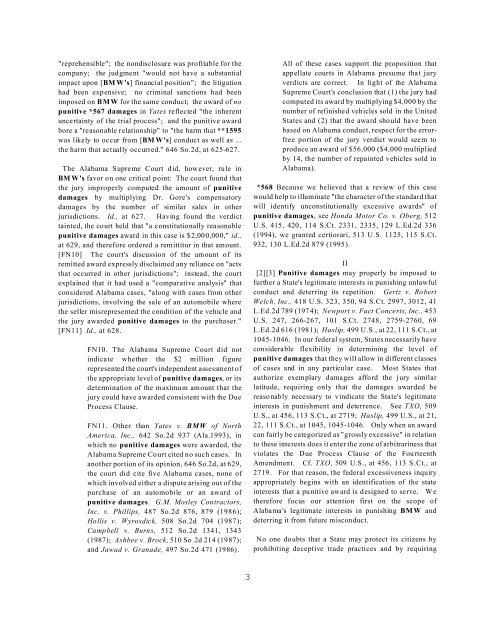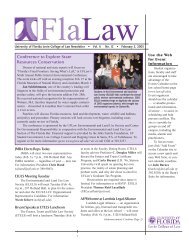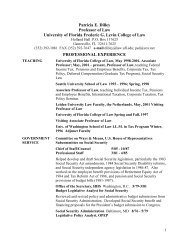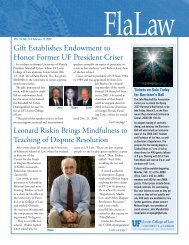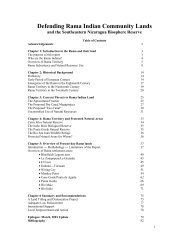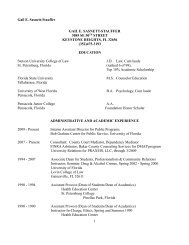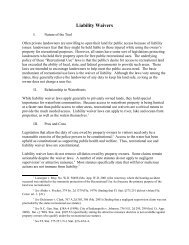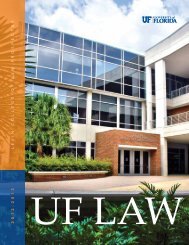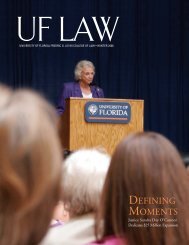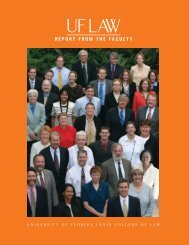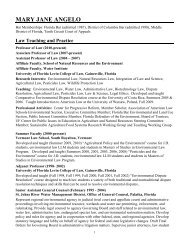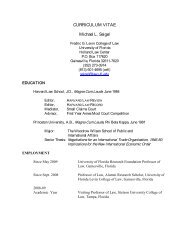TOPIC PUNITIVE DAMAGES Supreme Court of the United States ...
TOPIC PUNITIVE DAMAGES Supreme Court of the United States ...
TOPIC PUNITIVE DAMAGES Supreme Court of the United States ...
Create successful ePaper yourself
Turn your PDF publications into a flip-book with our unique Google optimized e-Paper software.
"reprehensible"; <strong>the</strong> nondisclosure was pr<strong>of</strong>itable for <strong>the</strong>company; <strong>the</strong> judgment "would not have a substantialimpact upon [BM W's] financial position"; <strong>the</strong> litigationhad been expensive; no criminal sanctions had beenimposed on BMW for <strong>the</strong> same conduct; <strong>the</strong> award <strong>of</strong> nopunitive *567 damages in Yates reflected "<strong>the</strong> inherentuncertainty <strong>of</strong> <strong>the</strong> trial process"; and <strong>the</strong> punitive awardbore a "reasonable relationship" to "<strong>the</strong> harm that **1595was likely to occur from [BM W's] conduct as well as ...<strong>the</strong> harm that actually occurred." 646 So.2d, at 625-627.The Alabama <strong>Supreme</strong> <strong>Court</strong> did, however, rule inBM W's favor on one critical point: The court found that<strong>the</strong> jury improperly computed <strong>the</strong> amount <strong>of</strong> punitivedamages by multiplying Dr. Gore's compensatorydamages by <strong>the</strong> number <strong>of</strong> similar sales in o<strong>the</strong>rjurisdictions. Id., at 627. Having found <strong>the</strong> verdicttainted, <strong>the</strong> court held that "a constitutionally reasonablepunitive damages award in this case is $2,000,000," id.,at 629, and <strong>the</strong>refore ordered a remittitur in that amount.[FN10] The court's discussion <strong>of</strong> <strong>the</strong> amount <strong>of</strong> itsremitted award expressly disclaimed any reliance on "actsthat occurred in o<strong>the</strong>r jurisdictions"; instead, <strong>the</strong> courtexplained that it had used a "comparative analysis" thatconsidered Alabama cases, "along with cases from o<strong>the</strong>rjurisdictions, involving <strong>the</strong> sale <strong>of</strong> an automobile where<strong>the</strong> seller misrepresented <strong>the</strong> condition <strong>of</strong> <strong>the</strong> vehicle and<strong>the</strong> jury awarded punitive damages to <strong>the</strong> purchaser."[FN11] Id., at 628.FN10. The Alabama <strong>Supreme</strong> <strong>Court</strong> did notindicate whe<strong>the</strong>r <strong>the</strong> $2 million figurerepresented <strong>the</strong> court's independent assessment <strong>of</strong><strong>the</strong> appropriate level <strong>of</strong> punitive damages, or itsdetermination <strong>of</strong> <strong>the</strong> maximum amount that <strong>the</strong>jury could have awarded consistent with <strong>the</strong> DueProcess Clause.FN11. O<strong>the</strong>r than Yates v. BMW <strong>of</strong> NorthAmerica, Inc., 642 So.2d 937 (Ala.1993), inwhich no punitive damages were awarded, <strong>the</strong>Alabama <strong>Supreme</strong> <strong>Court</strong> cited no such cases. Inano<strong>the</strong>r portion <strong>of</strong> its opinion, 646 So.2d, at 629,<strong>the</strong> court did cite five Alabama cases, none <strong>of</strong>which involved ei<strong>the</strong>r a dispute arising out <strong>of</strong> <strong>the</strong>purchase <strong>of</strong> an automobile or an award <strong>of</strong>punitive damages. G.M. Mosley Contractors,Inc. v. Phillips, 487 So.2d 876, 879 (1986);Hollis v. Wyrosdick, 508 So.2d 704 (1987);Campbell v. Burns, 512 So.2d 1341, 1343(1987); Ashbee v. Brock, 510 So.2d 214 (1987);and Jawad v. Granade, 497 So.2d 471 (1986).All <strong>of</strong> <strong>the</strong>se cases support <strong>the</strong> proposition thatappellate courts in Alabama presume that juryverdicts are correct. In light <strong>of</strong> <strong>the</strong> Alabama<strong>Supreme</strong> <strong>Court</strong>'s conclusion that (1) <strong>the</strong> jury hadcomputed its award by multiplying $4,000 by <strong>the</strong>number <strong>of</strong> refinished vehicles sold in <strong>the</strong> <strong>United</strong><strong>States</strong> and (2) that <strong>the</strong> award should have beenbased on Alabama conduct, respect for <strong>the</strong> errorfreeportion <strong>of</strong> <strong>the</strong> jury verdict would seem toproduce an award <strong>of</strong> $56,000 ($4,000 multipliedby 14, <strong>the</strong> number <strong>of</strong> repainted vehicles sold inAlabama).*568 Because we believed that a review <strong>of</strong> this casewould help to illuminate "<strong>the</strong> character <strong>of</strong> <strong>the</strong> standard thatwill identify unconstitutionally excessive awards" <strong>of</strong>punitive damages, see Honda Motor Co. v. Oberg, 512U.S. 415, 420, 114 S.Ct. 2331, 2335, 129 L.Ed.2d 336(1994), we granted certiorari, 513 U.S. 1125, 115 S.Ct.932, 130 L.Ed.2d 879 (1995).II[2][3] Punitive damages may properly be imposed t<strong>of</strong>ur<strong>the</strong>r a State's legitimate interests in punishing unlawfulconduct and deterring its repetition. Gertz v. RobertWelch, Inc., 418 U.S. 323, 350, 94 S.Ct. 2997, 3012, 41L.Ed.2d 789 (1974); Newport v. Fact Concerts, Inc., 453U.S. 247, 266-267, 101 S.Ct. 2748, 2759-2760, 69L.Ed.2d 616 (1981); Haslip, 499 U.S., at 22, 111 S.Ct., at1045-1046. In our federal system, <strong>States</strong> necessarily haveconsiderable flexibility in determining <strong>the</strong> level <strong>of</strong>punitive damages that <strong>the</strong>y will allow in different classes<strong>of</strong> cases and in any particular case. Most <strong>States</strong> thatauthorize exemplary damages afford <strong>the</strong> jury similarlatitude, requiring only that <strong>the</strong> damages awarded bereasonably necessary to vindicate <strong>the</strong> State's legitimateinterests in punishment and deterrence. See TXO, 509U.S., at 456, 113 S.Ct., at 2719; Haslip, 499 U.S., at 21,22, 111 S.Ct., at 1045, 1045-1046. Only when an awardcan fairly be categorized as "grossly excessive" in relationto <strong>the</strong>se interests does it enter <strong>the</strong> zone <strong>of</strong> arbitrariness thatviolates <strong>the</strong> Due Process Clause <strong>of</strong> <strong>the</strong> FourteenthAmendment. Cf. TXO, 509 U.S., at 456, 113 S.Ct., at2719. For that reason, <strong>the</strong> federal excessiveness inquiryappropriately begins with an identification <strong>of</strong> <strong>the</strong> stateinterests that a punitive award is designed to serve. We<strong>the</strong>refore focus our attention first on <strong>the</strong> scope <strong>of</strong>Alabama's legitimate interests in punishing BMW anddeterring it from future misconduct.No one doubts that a State may protect its citizens byprohibiting deceptive trade practices and by requiring3


